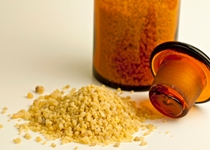 We don’t often hear about frankincense, though you may recognize the name of this herb from the biblical story of the three wise men bringing gifts to baby Jesus.
We don’t often hear about frankincense, though you may recognize the name of this herb from the biblical story of the three wise men bringing gifts to baby Jesus.
Well, as it turns out, these men really were “wise,” as their gift of frankincense was a very potent health healer. In fact, as recent research suggests, frankincense can kill ovarian cancer cells.
Frankincense a Potent Cancer-Fighter?
There was a time, long, long ago, when frankincense was praised as highly as gold by the wealthy—and rightfully so. It is considered an aromatic herbal gum resin that has treated health conditions for thousands of years.
Research also suggests that frankincense can treat cancers, including prostate, colon, and breast cancer. Frankincense is an herb derived from Boswellia sacra tree bark—mostly found in Arabia and Africa. I remember a study that made news around last holiday season that supports the anti-cancer effects of frankincense. It was the first of its kind to show that frankincense may also treat the late stages of ovarian cancer—considered the fifth most common cancer in women.
Ovarian cancer is a disease that caused an estimated 14,270 deaths in 2014, with 21,980 new cases in the U.S. When a person has ovarian cancer, they often also experience abdominal or pelvic pain, issues eating or feeling full quickly, and bloating. They may also urinate more frequently. These symptoms and ovarian cancer are often misdiagnosed in their early stages, meaning that oftentimes, this form of cancer is diagnosed during the late stages of the condition, when it’s more difficult to treat.
Study: How Frankincense Kills Ovarian Cancer
When ovarian cancer is detected possible treatment options often include surgery, chemotherapy, radiation therapy, or hormone therapy. However, there may be natural cures for cancer as well that don’t cause the side effects conventional therapies do.
How does frankincense help fight cancer? Researchers from the University of Leicester in the U.K. studied a compound found in frankincense—acetyl-11-keto-beta-boswellic acid (AKBA)—in vitro with ovarian cancer cell lines for a one-year period. They found that AKBA has the potential to kill ovarian cancer cells.
Must Read : Cancer Treatment from an Unlikely Source—Insects
The study also suggested that the frankincense compound can help people overcome the effects of chemotherapy and can improve late-stage ovarian cancer survival rates. However, greater research and clinical trials are required to understand how exactly the frankincense compound kills the ovarian cancer cells. Nonetheless it was a positive step in the right direction.
The Key Takeaway Point…
While researchers continue to offer new findings regarding natural cures, when it comes to cancer especially, you should always consult with your doctor before taking on any new treatments—natural or otherwise. It is important to understand that while frankincense and other natural cures are noted to have fewer side effects—if any at all—there is also the potential of harmful interactions with other drugs and treatments. So before taking any action, consult with your doctor to ensure you’re approaching your treatment both safely and effectively.
Also Read : This Marine Animal Could Help Fight Cancer
Sources for Today’s Article:
“Frankincense Superior to Chemotherapy in Killing Late-Stage Ovarian Cancer Cells,” GrennMedInfo web site, December 21, 2013; http://www.greenmedinfo.com/blog/frankincense-superior-chemotherapy-killing-late-stage-ovarian-cancer-cells, last accessed January 8, 2015.
“Ovarian Cancer,” National Cancer Institute web site; http://www.cancer.gov/cancertopics/types/ovarian, last accessed January 8, 2015.
“We bring gifts of gold, myrrh, and ovarian cancer treatment,” Medical News Today web site; http://www.medicalnewstoday.com/articles/270505.php, last accessed January 8, 2015.
“Frankincense Effective in Killing Ovarian Cancer Cells, Study,” University Herald web site, December 20, 2013; http://www.universityherald.com/articles/6350/20131220/frankincense-christmas-gift-ovarian-cancer-cells-leicester-university-gum.htm, last accessed January 8, 2015.
